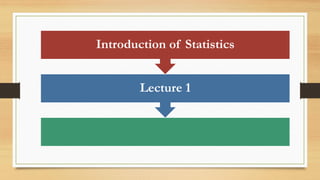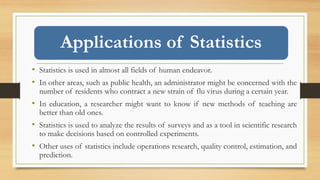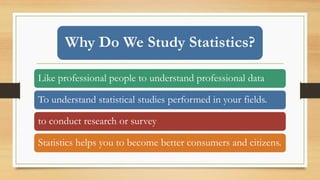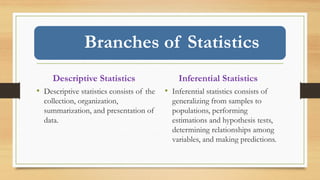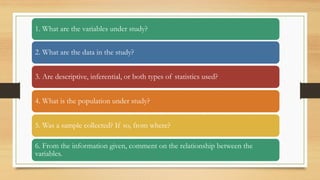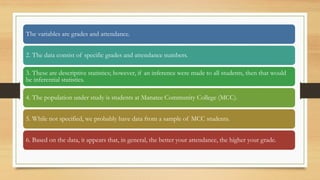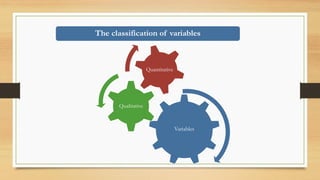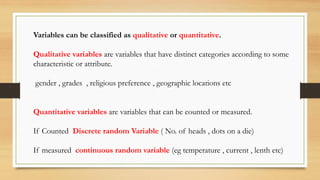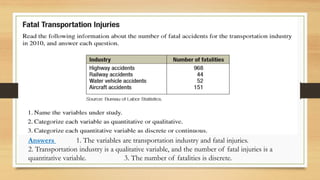Lect 1 Introduction Statistics.pdf
- 1. Lecture 1 Introduction of Statistics
- 2. Introduction of Statistics • Statistics as Singular (Subject) Statistics is the science of conducting studies to collect, organize, summarize, analyze, and draw conclusions from data. Statistic (Singular Without s ) Characteristics of Sample e.g mean ҧ 𝑥 & Standard deviation 𝑠 of sample • Statistics as Plural (Data) means Data (Facts and Figures) e.g No. of students in 18 Batch No. of Covid 19 Patient in Pak No of universities Teaching online
- 3. Applications of Statistics • Statistics is used in almost all fields of human endeavor. • In other areas, such as public health, an administrator might be concerned with the number of residents who contract a new strain of flu virus during a certain year. • In education, a researcher might want to know if new methods of teaching are better than old ones. • Statistics is used to analyze the results of surveys and as a tool in scientific research to make decisions based on controlled experiments. • Other uses of statistics include operations research, quality control, estimation, and prediction.
- 4. Why Do We Study Statistics? Like professional people to understand professional data To understand statistical studies performed in your fields. to conduct research or survey Statistics helps you to become better consumers and citizens.
- 5. Branches of Statistics Descriptive Statistics • Descriptive statistics consists of the collection, organization, summarization, and presentation of data. Inferential Statistics • Inferential statistics consists of generalizing from samples to populations, performing estimations and hypothesis tests, determining relationships among variables, and making predictions.
- 6. Example: Determine whether descriptive or inferential statistics were used. • a. The average jackpot for the top five lottery winners was $367.6 million. • b. A study done by the American Academy of Neurology suggests that older people who had a high caloric diet more than doubled their risk of memory loss. • c. Scientists at the University of Oxford in England found that a good laugh significantly raises a person’s pain level tolerance. • d. Forty-four percent of the people in the United States have type O blood. • e. In 2011, there were 34 deaths from the avian flu.
- 7. Terminology • A variable is a characteristic or attribute that can assume different values. • Data are the values (measurements or observations) that the variables can assume. • Each value in the data set is called a data value or a datum. • A population consists of all subjects (human or otherwise) that are being studied. • A sample is a group of subjects selected from a population.
- 8. Read the following on attendance and grades, and answer the questions. A study conducted at Manatee Community College revealed that students who attended class 95 to 100% of the time usually received an A in the class. Students who attended class 80 to 90% of the time usually received a B or C in the class. Students who attended class less than 80% of the time usually received a D or an F or eventually withdrew from the class. Based on this information, attendance and grades are related. The more you attend class, the more likely it is you will receive a higher grade. If you improve your attendance, your grades will probably improve. Many factors affect your grade in a course. One factor that you have considerable control over is attendance. You can increase your opportunities for learning by attending class more often.
- 9. 1. What are the variables under study? 2. What are the data in the study? 3. Are descriptive, inferential, or both types of statistics used? 4. What is the population under study? 5. Was a sample collected? If so, from where? 6. From the information given, comment on the relationship between the variables.
- 10. The variables are grades and attendance. 2. The data consist of specific grades and attendance numbers. 3. These are descriptive statistics; however, if an inference were made to all students, then that would be inferential statistics. 4. The population under study is students at Manatee Community College (MCC). 5. While not specified, we probably have data from a sample of MCC students. 6. Based on the data, it appears that, in general, the better your attendance, the higher your grade.
- 11. The classification of variables Variables Qualitative Quantitative
- 12. Variables can be classified as qualitative or quantitative. Qualitative variables are variables that have distinct categories according to some characteristic or attribute. gender , grades , religious preference , geographic locations etc Quantitative variables are variables that can be counted or measured. If Counted Discrete random Variable ( No. of heads , dots on a die) If measured continuous random variable (eg temperature , current , lenth etc)
- 13. Classify each variable as a discrete variable or a continuous variable. a. The highest wind speed of a hurricane b. The weight of baggage on an airplane c. The number of pages in a statistics book d. The amount of money a person spends per year for online purchases
- 14. a. Continuous, since wind speed must be measured b. Continuous, since weight is measured c. Discrete, since the number of pages is countable d. Discrete, since the smallest value that money can assume is in cents
- 15. Answers 1. The variables are transportation industry and fatal injuries. 2. Transportation industry is a qualitative variable, and the number of fatal injuries is a quantitative variable. 3. The number of fatalities is discrete.
- 16. Misuse of Statistics The misuse of statistical techniques is used to sell products To get our attention by using statistics to evoke fear, shock, and outrage. “Three out of four doctors surveyed recommend brand such and such.” suspected sample “During my administration, expenditures increased a mere 3%.” “Brand A aspirin works four times faster.” Detached Statistics “Studies suggest that using our exercise machine will reduce your weight.” “Taking calcium will lower blood pressure in some people.”
- 17. Two sayings that have been around for a long time illustrate this point: “There are three types of lies—lies, damn lies, and statistics.” “Figures don’t lie, but liars figure.”
